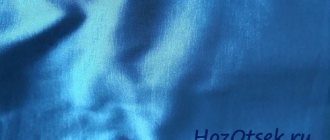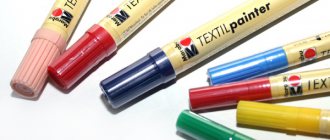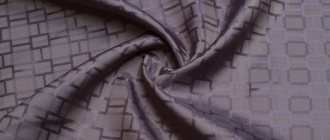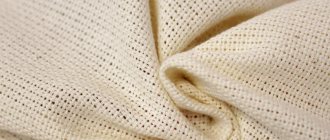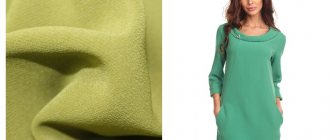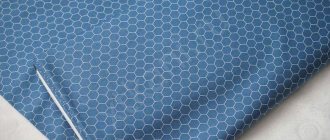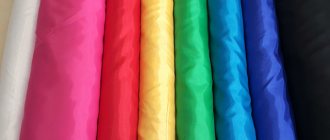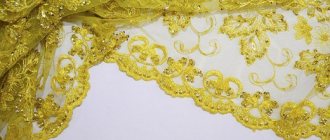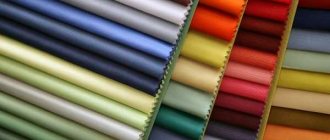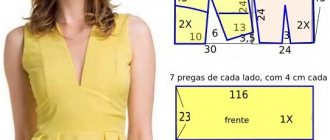Satin fabric is the name given to dense silk or semi-silk fabric, which has been known to mankind since ancient times. These fabrics are distinguished by a special, almost invisible satin weave. Canvases created in this way have a smooth front surface with a characteristic shine. This property of the satin is achieved due to the fact that the weft comes out through five or six warp threads to the front side. However, if we are talking about double-sided satin, then the weaving method is slightly different: the weft is hidden by two warp threads in between. Satin varies in composition, but historically this fabric was created from silk raw materials. Therefore, not everyone could afford to purchase this luxurious canvas. Beautiful iridescent fabric is great for sewing holiday items that will make you feel as impressive as possible.
History of the atlas
Satin fabric was first created more than 2000 years ago in China, in the port city of Quanzhou. But the word “atlas” itself is of Arabic origin and is translated as “smooth.” The nuances of producing this dense silk fabric were kept secret for a long time. Noble satin with its characteristic even shine remained the privilege of a narrow privileged group of people - clergy, emperors and representatives of the nobility. Even many years later, when the technology for creating the atlas became publicly available, the peculiarities of the extraction of silk raw materials did not allow it to be turned into a mass product. And these days, not everyone can afford to buy this durable silk fabric, but products made from satin look elegant and noble.
However, thanks to the invention of synthetics in the 20th century, it was possible to produce an atlas that almost everyone could afford. Of course, synthetic satin is significantly different from silk satin, but in terms of external parameters it is almost as good as its expensive and rarer predecessor.
Usage
The scope of the atlas is becoming wider and wider.
Satin is a fabric from which:
- Elegant women's and men's clothing (evening dresses, wedding dresses, tuxedos, ties).
- Casual clothes (blouses, trousers, skirts, shorts, sundresses).
- Women's underwear.
- Bed sheets.
- Room decor items (tablecloths, curtains, capes).
- Bows for children.
- Decorations for weddings and banquets.
- Inserts, trim for clothing.
- Lining for fur products.
- Tightening shoes.
Features of atlas production
The main feature of creating satin is the weave, satin or satin. Already from this name one can judge that the fabric received such a name precisely in honor of the weaving, and not the composition. Therefore, it is not one or another type of raw material that determines whether a fabric is classified as satin, but rather the type of weave. Yes, initially satin was mainly made from natural silk. This unique fabric comes at a high price. But today you can find budget blended options in which various synthetic and natural threads are added to silk. It can be either cotton or viscose, or polyester, nylon or acetate. There is also synthetic satin without the addition of silk at all.
The essence of satin weave is as follows: the warp threads are mostly released on the front side, overlapping the weft. It is this feature that influences the characteristic appearance of the atlas. One side of the fabric is shiny and smooth, and the back is also smooth, but matte.
Variety of atlas composition
In today's dynamic world, even centuries-old traditions are being transformed, so it is not surprising that satin made from natural silk is becoming less and less common. It is the cost of production and the high cost of raw materials that make such a canvas truly appreciated. In TISSURA you will find a variety of satin silk fabrics from leading European brands with which designers collaborate around the world. More information about the paintings can be found on our website, where additional information about the atlas is also published.
At the same time, manufacturers have learned to create high-quality satin from other materials; the most popular non-silk options are:
- cotton;
- acetate;
- viscose;
- polyester.
The raw materials for creating satin can be a variety of fabrics, both natural and synthetic or artificial. The most important thing that characterizes satin is the method of weaving, so you should pay attention not only to the desired composition, but also to the features of the texture of the fabric. It will be difficult for an unprofessional eye to determine the weaving method, so contact trusted companies to purchase real satin. At the TISSURA Fabric House, textile professionals will always advise you and help you choose not only the right fabric, but also harmonious accessories.
Methods for removing stains and gloss
If stains are found on a satin item, they must be removed before the main wash.
In most cases, you can see unpleasant greasy stains. If they are fresh, then a gentle dabbing with a clean rag will help as an emergency measure. Active friction will only aggravate the situation, and the fat will be reliably absorbed into the fibers of the material.
Then the traces of the grease stain are thoroughly sprinkled with wheat or corn flour so that most of the fat molecules are absorbed into it. For this procedure you will need to leave the product for an hour. Next, the item is cleaned of powder using a soft bristle brush and washed.
If satin fabric is improperly washed and ironed, glossiness may appear on its surface. Such defects will be immediately visible to the naked eye, and this will spoil the entire appearance of a beautiful shiny product. The method of getting rid of gloss is quite simple. The main assistant is 9% table vinegar. The gauze is soaked with it, the excess moisture is squeezed out and then the gauze is applied to the contaminated area and, lightly touching the sole of the iron, the area of gloss is treated with steam. As a rule, such a procedure is quite sufficient to return the item to its original appearance.
Varieties of patterns
The design of the atlas is not limited by strict rules; it can be either patterned or plain. Patterns can be applied in different ways:
- Direct printing method. The design is transferred to the finished fabric using special inks and a printing block. It has better detail, a wider range of colors and additional effects than silkscreen printing.
- Jacquard. Wrinkle-resistant fabric with a pattern made of complex weaving. The image on the front side is identical to the back side, but the lines are mirrored. Such satin is usually considered a curtain fabric.
- Embroidery. It can be done either manually or using modern machines or machines.
- Embossing. This artistic finishing of the fabric is quite extraordinary. It involves creating a three-dimensional image on a surface. This method requires the use of an engraved thermal roller.
Varieties of natural silk
The most delicate fabric is obtained from a continuous thread secreted by the secretory glands of the silkworm when curling the cocoon before it turns into a pupa. The type of silk produced depends on the type of silkworm. There are only two of them - Mulberry silk and Tussa silk.
Mulbery is the best variety of silk, which is obtained from the smooth, thin thread of the silkworm, domesticated about 3,000 years ago. This variety is also called mulberry silk or “cultivated silk.”
On special farms, a large and fluffy moth is artificially bred and raised, which over the years of selection has forgotten how to fly and has become blind. Its only purpose is to lay eggs and die. The emerging caterpillars are fed only mulberry (mulberry) leaves. Before turning into a pupa, they release a single long thread, which they wrap around themselves in the form of a silk cocoon.
The process of growing caterpillars, silk cocoons and further processing of silk thread is complex. Many operations are still performed manually. Therefore, Mulberry silk is quite expensive. Most silk fabrics are produced from it: crepe, toile, satin, crepe de Chine, chiffon and others. Initially, the canvas turns out to be milky in color (ivory, bleached). It is then stamped.
Tussa silk is made from yarn woven from wild silkworms. A wild butterfly, unlike the domesticated silkworm, can fly, lives in the wild in natural conditions and continues its genus. Its caterpillars feed not only on mulberry leaves, but also on any vegetation.
The threads from the cocoon of a wild silkworm are not wound manually, as in the first case, but are combed. The thread turns out to be not quite thin and even, with thickenings and irregularly shaped interceptions in some places. Therefore, the fabric produced from it is heterogeneous in structure. The tussah silk group includes fabrics such as dupont and chesucha. The canvas can be unpainted, patterned or painted.
Types of atlas
- Crash. This type of crinkled fabric appeared in the 1980s. The main difference between cracked fabric is the long-lasting creases and folds that are produced using the press method. Easy to use as they do not require ironing.
- Crepe. Double-sided fabric with a slightly rough texture. Crepe-satin is made from tightly twisted threads, which is why it hardly wrinkles, has high strength and breathability.
- Satin. The fabric is made entirely from natural fibers of cotton and silk.
- Stretch. Such satin fabrics have stretch thanks to the elastane in their composition. Products made from elastic stretch satin fit exactly to your figure and hardly wrinkle.
- Duchess. Rigid, dense and at the same time light and delicate fabric, which has become famous as a premium fabric. Plain or embroidered milky or white duchess is often used for sewing wedding dresses.
- DuPont. Another type of exclusive silk fabric with high density and shiny surface.
- Taffeta. A luxurious fabric that originated in Persia, whose name in Persian literally translates to “woven cloth.” Taffeta is quite dense, but at the same time thin, holds its shape and can be draped.
- Antique. A fabric with a bright texture due to the alternation of thick and thin threads in the weft.
Length
As before, all satin dresses are considered fashionable - covering the ankle, reaching to the knee or reaching mid-thigh. Asymmetry is welcomed, which makes the image elegant.
Long to the floor
Laconic straight maxis highlight one aspect of the figure. A high slit on the side of the hem slightly opens the leg, creating dynamics when walking. Classics are also in trend. These can be closed styles with long sleeves, stand-up collars or frivolous outfits with an open back, bare shoulders and openwork inserts.
More details
33,500 ₽ CRUCIANI Short dress
More details
RUR 4,200 JIJIL Midi dress
More details
RUB 25,710 CLIPS Midi dress
More details
RUR 51,700 BADGLEY MISCHKA Long dress
More details
RUR 2,350 KAOS Short dress
More details
RUB 20,450 JW ANDERSON Midi dress
The “mermaid” model looks interesting. The skirt fits the upper thigh, expanding towards the bottom in the shape of a fishtail. The beauty of the silhouette is emphasized by the deep neckline and tight bodice. Embroidery with shining beads, rhinestones, and gilded threads is possible.
A short
A popular mini style is summer slip dresses made of thick satin. These are shortened straight “spaghetti” on narrow straps, often decorated with braid and lace.
Another trend is the A-line silhouette. A mid-thigh skirt is a classic A-line piece. Her companions:
- open shoulders;
- short sleeves (regular or frilled);
- round neck;
- V-neckline.
More details
RUB 10,500 LIVIANA CONTI Midi dress
More details
930 ₽ SHEIN Satin dress with cutout back
More details
RUB 21,850 REDEMPTION Short dress
More details
RUR 11,700 BEATRICE .b Midi dress
More details
RUB 80,500 BRUNELLO CUCINELLI Midi dress
More details
12,800 ₽ LIU JO Long dress
Midi lengths
The golden mean is fashionable knee-length outfits. These include cocktail dresses with different cuts. The corset top is combined with a bottom, which can be:
- lush, with multi-layered petticoats made of tulle or organza;
- massive, “balloon” type;
- slightly expanding, trapezoidal;
- strict, straight form.
Another option is clothing with a pleated skirt. It suits those with narrow hips. Also popular are midi styles in the “new look” style with a fitted bodice and sun-shaped hem.
More details
RUR 17,350 RACHEL ZOE Long dress
More details
RUR 3,600 OTTOD AME Midi dress
More details
RUR 5,100 DIXIE Midi dress
-15%
More details
RUB 1,289 SHEIN satin bodycon dress with lace sleeves and deep collar
More details
RUR 5,850 MALIPARMI Midi dress
More details
RUB 25,750 ANN DEMEULEMEESTER Long dress
Application area
Luxurious satin has a wide range of applications:
- Smoothness and shine turns satin into a win-win option for elegant items for going out. It is chosen for sewing evening dresses, festive skirts, wedding dresses and suits.
- The distinctive characteristics of delicate satin make it possible to use it for sewing everyday clothes, for example, delicate blouses or men's shirts.
- Often the choice falls on satin when you want to sew a cute set of children's or women's underwear.
- A popular option for sewing beautiful linings suitable for coats or raincoats.
- Elegant accessories and jewelry are sewn from satin fabric: ties, hats, gloves... Satin is also used for the production of shoes, for example, pointe shoes.
As will be mentioned below, satin is used to create practical, but at the same time stylish home textiles.
Pros of fabric
The benefits of fabric certainly depend on the composition of the fabric. However, we can give a general list of advantages characteristic of the atlas as a whole.
- The fabric is hygroscopic. Satin is highly permeable to moisture and dries quickly enough. Drying a satin product is not at all difficult.
- Not electrified. Satin products do not need to be treated with an antistatic agent to prevent them from accumulating static electricity.
- Hypoallergenic. This applies to satin made from natural fibers, which is suitable for sensitive and children's skin. This is explained by the fact that satin fabric does not retain dust, so dust mites cannot grow there. However, “natural” is not always synonymous with “hypoallergenic”, since allergies can occur to a variety of fabrics. In the case of synthetic or artificial fabrics, the body’s reaction is also difficult to predict. But lyocell, which has a bactericidal effect, can be considered a completely reliable option.
- Durability, wear resistance and strength. Satin requires some care; only in this case will products made from this material look decent for as long as possible.
- Good drape, opacity. These properties make satin indispensable when it comes to making interior decor. An elegant solution for sewing curtains, bedspreads or bed linen.
Disadvantages of the material
- Before washing the product at high temperatures, familiarize yourself with the washing requirements and recommendations. If you increase the temperature of the water to critical levels, the atlas may lose its shape and shrink.
- The satin is quite loose. This disadvantage is especially obvious if the satin fabric is torn or cut.
- It can stretch, almost like knitwear, if we are talking about elastane in the composition, which can cause deformation of the product.
- The weight of the fabric can also be considered a disadvantage; some fabrics can be quite heavy.
Compound
Natural satin fabrics contain a large percentage of silk fibers. But the composition of the fabric varies depending on the purpose. Materials with the addition of cotton have proven themselves well. These are completely natural fabrics that are cheaper than 100% silk due to the introduction of cotton fibers.
Viscose, polyester, and nylon are also found in the satin material. Additives change the characteristics of the product and affect its cost. The higher the synthetic content, the more affordable the material. The gymnastic satin ribbon contains viscose or acetate silk.
Completely synthetic products do not contain silk fibers, but they look very similar to natural satin. Such materials are used to make budget items and are never used by haute couture craftsmen. Despite the external resemblance to silk, synthetics feel different to the touch and do not provide the same comfort when worn.
Care instructions
- Machine washable without spinning, in cool water. We recommend choosing a gentle cycle and delicate detergents, or it is better to wash the fabric by hand, soaking the item first.
- Do not rub or twist the satin during this process.
- Do not tumble dry. Proper drying is permissible not vertically, but horizontally on a towel.
- Some items require dry cleaning.
- You can iron from the inside out, but not at high temperature and through additional protective fabric.
- Storage tip: Use covers stored in dry, cool places.
Flaws
In addition to the advantages, the satin material also has disadvantages. The main disadvantage is the high price - not everyone can buy natural silk. Among other disadvantages:
- tendency to deformation - especially often problems arise with acetate material;
- increased flowability - poorly processed edges or a hole promises to result in delamination of the threads;
- shrinks - high temperatures contribute to the compression of the material;
- significant weight - the denser the material, the heavier the product made from it;
- capriciousness in care - improper washing or ironing will instantly ruin the item.
Customer Reviews
Most of our clients agree on satin: its pleasant shine, smoothness and strength make this fabric truly competitive in the modern textile world. However, the problem of the high price of satin, even made from artificial fibers, is still relevant.
The catalog of the TISSURA Fabric House presents a wide selection of satin fabrics, both for dresses or blouses, and for suits or linings. Our consultants will be happy to help you calculate the required number of meters, select accessories, and answer all your questions, for example, about the possibility of purchasing in bulk.
How is natural silk produced?
Modern technology for the production of silk fabric is not much different from that used by the Chinese thousands of years ago. This process is painstaking and requires constant attention. Although some operations are certainly automated.
The full life cycle of a silkworm, the main producer of raw materials for silk fabric, takes an average of two months. The butterfly lays eggs (greens). Their number reaches 500 pieces. Depending on the selection, they are Chinese, European, Asian, Japanese, Cypriot, Persian.
Greens in the process of making silk fabric are of particular value. At rest and under certain conditions, they remain viable for two years. If it is necessary to revive them, the temperature in the incubator is gradually increased and on days 7-12 very small (up to 2 mm) silkworm worms appear from the eggs. For a month, all they do is constantly eat and grow quickly. To feed the voracious worms, huge mulberry plantations are grown.
An adult individual transforms from a two-millimeter worm into a caterpillar 5-7 cm long. It can form a thread up to 1 km long. To do this, the caterpillar curls a cocoon on a branch and begins to secrete a viscous substance with its secretory glands, which instantly hardens in the air and turns into a thread. The pupation process takes two to three days.
After the cocoon formation is completed, they are sorted. The main part goes to fabric production. The best specimens are left for subsequent production of offspring. After 12-15 days, a silkworm butterfly will emerge from them, lay eggs and die.
Cocoons selected for production are poured with boiling water to free them from the sticky viscous substance - sericin. Then the thinnest thread is carefully rewound from the cocoons onto the bobbin on reel machines. To obtain a thick fabric, up to 20 fibers are joined together. For thin fabric, it is enough to connect 5-8 fibers.
Finished threads in skeins are called raw silk. They are first painted. Then they are sent to the looms to weave silk fabric.
Interesting numbers: 1000 cocoons are required to sew a silk women's dress. And to raise 1000 caterpillars you will need two or three mulberry trees or approximately 60 kg of leaves.
Where are silk fabrics used?
The main direction where natural silk has retained its undivided dominance over other fashionable fabrics is tailoring. Silk textiles offer unlimited possibilities in creating various models of women's, men's, and children's clothing.
Excellent draping silk fabrics look great in the interior. Silk bed linen, curtains, bedspreads, and decorative accessories are made from light flowing fabric. More dense types include furniture covers and curtains.
Bactericidal silk thread is used in medicine. It is used in surgery as a suture material. The amino acid it contains disinfects the wound and accelerates healing.
Texture
The satin comes in a variety of textures. There are plain-colored varieties with a single-color structure; jacquard, striking with their patterns. Materials with prints are usually divided into 2 groups.
By drawing method
The heterogeneity of patterned satin is due to different technologies. There are several types of fabric:
- Jacquard. On the outer surface there is a single-color or multi-colored pattern, which is obtained thanks to a special weave.
- Printed. In production, a special printer is used that applies dyes to the finished canvas.
- Embossed. The design is extruded using an engraved thermal machine.
- Embroidered. Previously, embroidery with colored threads was done by hand. Today embroidery machines are used for this.
Thermal printing uses durable, hypoallergenic, environmentally friendly inks. They do not fade, do not fade and are not capable of causing harm to health.
By type of ornament
The atlas is also distinguished by the style of the patterns:
- Maintenon. A distinctive feature is a pattern in the form of an imprint applied to a plain fabric. This name is in honor of the favorite of Louis XIV.
- Trianon. Its main feature is contrast. A light floral design (bouquets, clusters, leaves) is depicted on a dark background. On the light one there is a dark ornament. The name was given by the French village.
- Pompadour. The design is woven with gold or silver threads on a dark background. In this way, French weavers wanted to please Louis XV, glorifying his favorite.
Note: There is another complex pattern due to weaving technology. They call it Khan's silk. Threads of different colors form a pattern with smooth gradients, shimmering in different shades. In the West, Khan’s canvas is called “ikat”, which means “to unite”, “to bind”. This material is often used for sewing oriental national costumes.
Advantages
The advantages of the atlas include:
- Durability. With proper care, the fabric retains its original shine and brightness of colors for a long time.
- Drapability. This quality is especially important when decorating interiors.
- Hygiene. The material does not accumulate dust, which makes it safe even for allergy sufferers.
- Opacity. This is why satin curtains are so highly valued.
- Elasticity. This is especially true for varieties with the addition of lycra.
Thanks to this set of advantages, consumers fell in love with satin not only made from natural fibers, but also with the addition of various impurities.\
